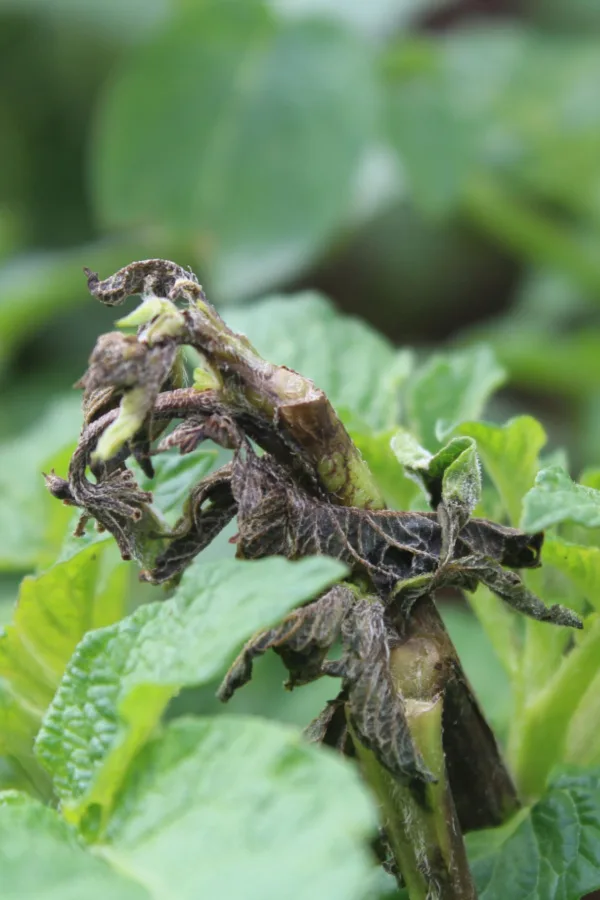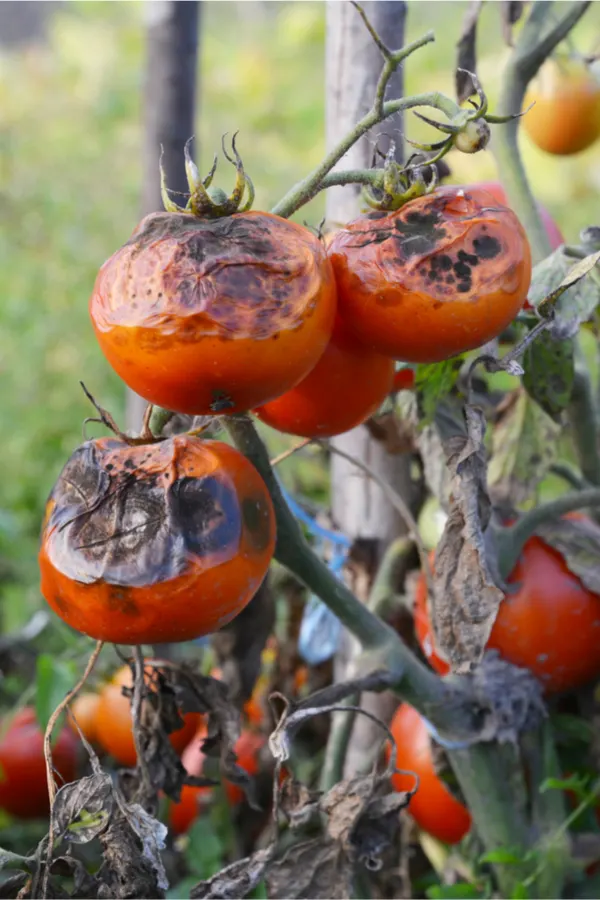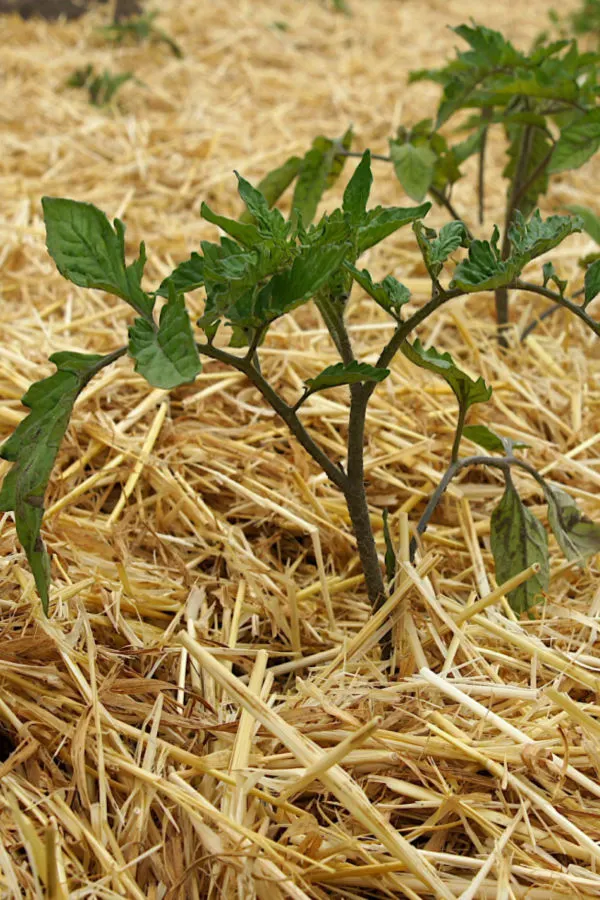Worried that your tomato plants might be showing signs of tomato blight and wondering how to stop it? Or more importantly – wondering if there is anyway at all to save your plants and your harvest?
As summer arrives in full force, the threat of blight does as well. There is nothing more frustrating for a gardener than to see their once healthy and beautiful tomato plants begin to show the first tell-tale signs of blight.
It can start out with just a few small dark circles or spots that appear on a tomato plant’s lower leaves. And it only gets worse. Before long, more and more spots begin to show up and begin to form small circles within the spots. It is certainly devastating to watch – especially as your entire tomato crop begins to become infected.
From there, it’s all downhill. The plant slowly begins to fade away. The leaves turn brown or black and begin falling from the plant. Those that don’t fall off cling to their stems by a thread. Before long, the plant’s fruit begins to fail as well, and the entire plant begins to wither away and die.
And here is the really bad news – not only is the hope of a good harvest gone, but the health of future tomato plants that grow in the same soil can be jeopardized as well.
Is It Possible To Stop Tomato Blight?
The biggest question most people have when it comes to blight is wondering if there is really any way to stop it on the plant once it shows up. Although there are a few “quick fixes” you can try that can sometimes help, in order to have any chance at stopping the disease, you have to act swiftly.
One thing is for sure, without any action at all, blight will take out the infected plants. And most likely, any other tomato plants around it as well. And if you have other susceptible vegetable plants nearby such as potatoes or peppers, it can wipe them out too.
As you will see below, there are a few remedies that have a bit of success in dealing with a plant infected by blight. But more than anything else, it is first important to rid your plants of any infected limbs, foliage and fruit.

Then and only then, you give yourself at least half a fighting chance against the tomato killing disease. With that in mind, here is what to do to your tomato plants when they show the first signs of blight.
Dealing With Tomato Blight – What To Do If You Think Your Plants Have Blight
In the fight against bight, it’s important to know how the disease starts and spreads. Blight is caused by soil born spores that become airborne and then land on the foliage of plants.
Most often, the spores live in the soil below plants, where a hard rain or even a garden watering can splash them on to lower limbs. Spores can also be picked up by a strong wind or current as well. However they arrive, once on the plant, they begin to infect it quickly.
The best way to fight blight and win is with an aggressive approach. First and foremost, begin checking your tomato plants for blight early in the growing season. The earlier you see the first sign and take the appropriate action, the better chance of success.
Remove any suspicious foliage immediately. It is best to remove the entire stem or branch where you see the infection – even if it is only on a single leaf or two. Most likely, the disease has begun to spread further than the damage that is visible.

Clean Your Pruners!
We often talk about disinfecting your pruners or scissors between use. But with blight, you need to be wiping down the blades of your pruners between every plant. The spores can easily spread from the blades of your shears right to the next plant you use them on.
To disinfect, dip in a solution of bleach and water, or wipe or spray off with a disinfectant. This little process can stop the spread more than you know! Product Link: CleanSmart Disinfectant Spray
Any and all limbs should be discarded immediately. If you have a fire pit, you can burn them to kill the spores. If not, wrap up tightly in plastic and discard in your trash. Never place any blight or potentially blight infected material in a compost bin or pile.
Mulch & Prune Immediately – How To Stop Tomato Blight
If you have not done so already, now is also the time to mulch your soil heavily. A four to six inch layer of straw can help keep any additional spores from splashing up. In addition, this is also the time to prune up underneath your tomato plants.
By pruning up ten to twelve inches at minimum, you make it harder for spores to find their way onto the bottom leaves of the plant. Again, burn or discard any of the limbs. Also disinfect your pruners between each and every plant.
If your plants have grown together thickly, it is also a good idea to prune a bit out of the middle to allow for better air flow. When plants remain moist without circulation, the chance for blight to take hold increases.
Pruning can really help to keep your plants healthy for so many reasons – and it is a great practice to get in the habit of – whether you have blight issues or not.
Additional Ways To Keep Plants Safe – How To Stop Tomato Blight
There are a few additional precautions to take to help to keep your plants safe. When watering your plants, water low and slow at the base. Splashing water can easily splash spores up onto plants, or from plant to plant.
In addition, water only in the morning, as wet or moist plants overnight can be troublesome – both for spores, and for inviting mildew to the party too.
If a plant does become heavily infected, pick off any and all of the unripe tomatoes that show no signs of damage. These should still be able to ripen off the vine. Once a plant is infected, it will not ripen on the vine. In addition, leaving the plant can only serve to spread blight more.
Finally, take note of where your affected tomato plants grew. Make a note to not plant your tomatoes in that spot for at least three years. Doing so would only be setting your plants up for a yearly battle with blight. See: How To Prevent Tomato Blight For Good – 2 Simple Secrets To Stop Blight For Good

A Remedy To Try – Dealing With Tomato Blight
Homemade Baking Soda & Vegetable Oil Spray – How To Stop Tomato Blight
If your plants have been infected, there is a homemade spray you can apply to try to minimize damage and in some cases, stop the spread entirely. The solution is made from water, baking soda and vegetable oil. It can be applied directly to your plants as both a remedy and a deterrent.
To make, mix 1.5 tablespoons of baking soda and 1.5 tablespoons of pure vegetable oil into one (1) gallon of distilled or non-treated water. To use, apply with a clean pump or hand held sprayer, coating the leaves and stems of the plant.
The antibacterial qualities of the baking soda are thought to provide protection. The vegetable oil acts as a binding agent, helping the spray stick to the plants. For full effectiveness, reapply every week, or any time you have a rain that can wash it off.
Here is to trying to stop blight and save as much of your tomato crop as possible. Happy Gardening – Jim and Mary.
Old World Garden
Jim and Mary Competti have been writing gardening, DIY and recipe articles and books for over 15 years from their 46 acre Ohio farm. The two are frequent speakers on all things gardening and love to travel in their spare time.
As always, feel free to email us at thefarm@owgarden.com with comments, questions, or to simply say hello! You can sign up for our free email list in the subscribe now box in the middle of this article. Follow us on Facebook here : OWG Facebook. This article may contain affiliate links.


